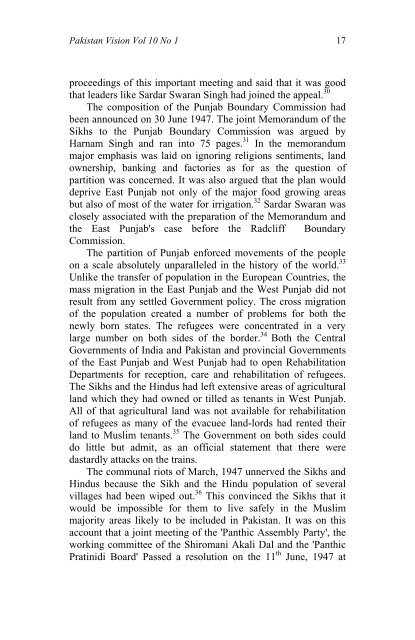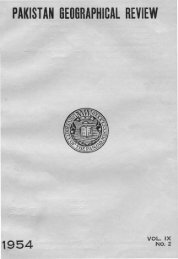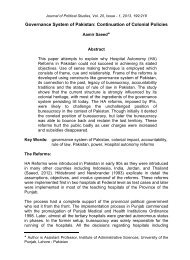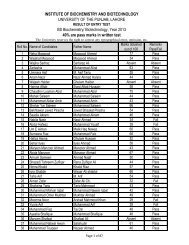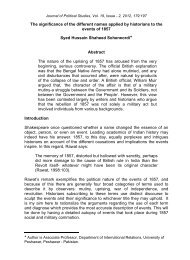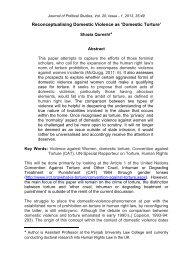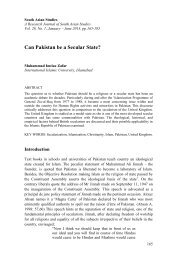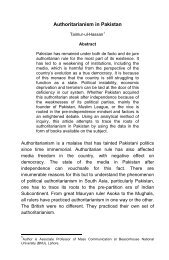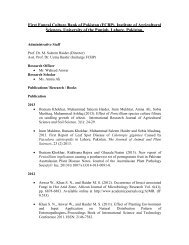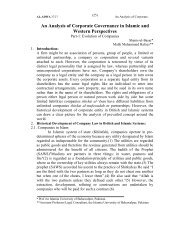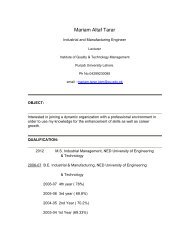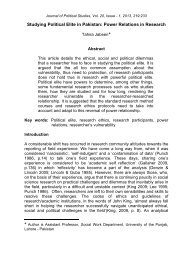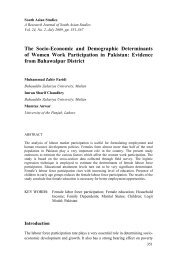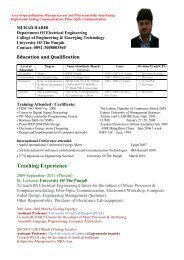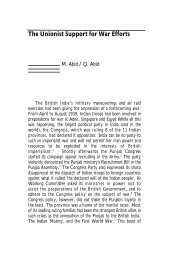Sardar Swaran Singh (1907-1994) - University of the Punjab
Sardar Swaran Singh (1907-1994) - University of the Punjab
Sardar Swaran Singh (1907-1994) - University of the Punjab
You also want an ePaper? Increase the reach of your titles
YUMPU automatically turns print PDFs into web optimized ePapers that Google loves.
Pakistan Vision Vol 10 No 1 17<br />
proceedings <strong>of</strong> this important meeting and said that it was good<br />
that leaders like <strong>Sardar</strong> <strong>Swaran</strong> <strong>Singh</strong> had joined <strong>the</strong> appeal. 30<br />
The composition <strong>of</strong> <strong>the</strong> <strong>Punjab</strong> Boundary Commission had<br />
been announced on 30 June 1947. The joint Memorandum <strong>of</strong> <strong>the</strong><br />
Sikhs to <strong>the</strong> <strong>Punjab</strong> Boundary Commission was argued by<br />
Harnam <strong>Singh</strong> and ran into 75 pages. 31 In <strong>the</strong> memorandum<br />
major emphasis was laid on ignoring religions sentiments, land<br />
ownership, banking and factories as for as <strong>the</strong> question <strong>of</strong><br />
partition was concerned. It was also argued that <strong>the</strong> plan would<br />
deprive East <strong>Punjab</strong> not only <strong>of</strong> <strong>the</strong> major food growing areas<br />
but also <strong>of</strong> most <strong>of</strong> <strong>the</strong> water for irrigation. 32 <strong>Sardar</strong> <strong>Swaran</strong> was<br />
closely associated with <strong>the</strong> preparation <strong>of</strong> <strong>the</strong> Memorandum and<br />
<strong>the</strong> East <strong>Punjab</strong>'s case before <strong>the</strong> Radcliff Boundary<br />
Commission.<br />
The partition <strong>of</strong> <strong>Punjab</strong> enforced movements <strong>of</strong> <strong>the</strong> people<br />
on a scale absolutely unparalleled in <strong>the</strong> history <strong>of</strong> <strong>the</strong> world. 33<br />
Unlike <strong>the</strong> transfer <strong>of</strong> population in <strong>the</strong> European Countries, <strong>the</strong><br />
mass migration in <strong>the</strong> East <strong>Punjab</strong> and <strong>the</strong> West <strong>Punjab</strong> did not<br />
result from any settled Government policy. The cross migration<br />
<strong>of</strong> <strong>the</strong> population created a number <strong>of</strong> problems for both <strong>the</strong><br />
newly born states. The refugees were concentrated in a very<br />
large number on both sides <strong>of</strong> <strong>the</strong> border. 34 Both <strong>the</strong> Central<br />
Governments <strong>of</strong> India and Pakistan and provincial Governments<br />
<strong>of</strong> <strong>the</strong> East <strong>Punjab</strong> and West <strong>Punjab</strong> had to open Rehabilitation<br />
Departments for reception, care and rehabilitation <strong>of</strong> refugees.<br />
The Sikhs and <strong>the</strong> Hindus had left extensive areas <strong>of</strong> agricultural<br />
land which <strong>the</strong>y had owned or tilled as tenants in West <strong>Punjab</strong>.<br />
All <strong>of</strong> that agricultural land was not available for rehabilitation<br />
<strong>of</strong> refugees as many <strong>of</strong> <strong>the</strong> evacuee land-lords had rented <strong>the</strong>ir<br />
land to Muslim tenants. 35 The Government on both sides could<br />
do little but admit, as an <strong>of</strong>ficial statement that <strong>the</strong>re were<br />
dastardly attacks on <strong>the</strong> trains.<br />
The communal riots <strong>of</strong> March, 1947 unnerved <strong>the</strong> Sikhs and<br />
Hindus because <strong>the</strong> Sikh and <strong>the</strong> Hindu population <strong>of</strong> several<br />
villages had been wiped out. 36 This convinced <strong>the</strong> Sikhs that it<br />
would be impossible for <strong>the</strong>m to live safely in <strong>the</strong> Muslim<br />
majority areas likely to be included in Pakistan. It was on this<br />
account that a joint meeting <strong>of</strong> <strong>the</strong> 'Panthic Assembly Party', <strong>the</strong><br />
working committee <strong>of</strong> <strong>the</strong> Shiromani Akali Dal and <strong>the</strong> 'Panthic<br />
Pratinidi Board' Passed a resolution on <strong>the</strong> 11 th June, 1947 at


